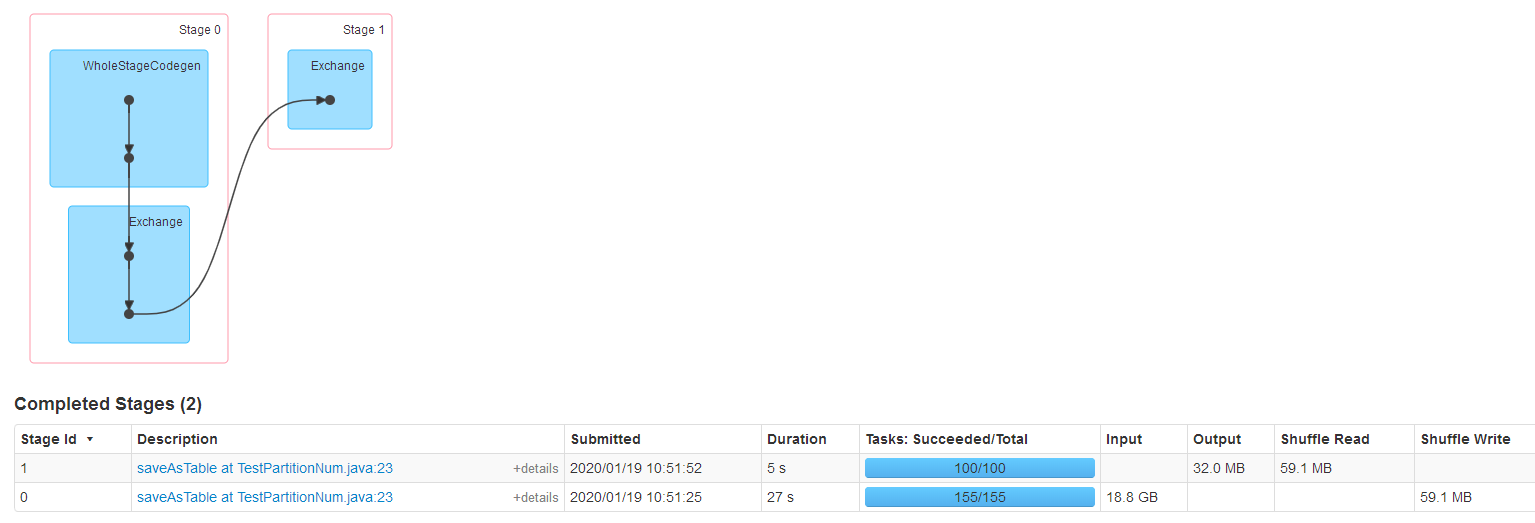dataset的reparation和coalesce
/**
* Returns a new Dataset that has exactly `numPartitions` partitions, when the fewer partitions
* are requested. If a larger number of partitions is requested, it will stay at the current
* number of partitions. Similar to coalesce defined on an `RDD`, this operation results in
* a narrow dependency, e.g. if you go from 1000 partitions to 100 partitions, there will not
* be a shuffle, instead each of the 100 new partitions will claim 10 of the current partitions.
*
* However, if you're doing a drastic coalesce, e.g. to numPartitions = 1,
* this may result in your computation taking place on fewer nodes than
* you like (e.g. one node in the case of numPartitions = 1). To avoid this,
* you can call repartition. This will add a shuffle step, but means the
* current upstream partitions will be executed in parallel (per whatever
* the current partitioning is).
*
* @group typedrel
* @since 1.6.0
*/
def coalesce(numPartitions: Int): Dataset[T] = withTypedPlan {
Repartition(numPartitions, shuffle = false, planWithBarrier)
}
关于coalsece:
1、用于减少分区数量,如果设置的numPartitions超过目前实际有的分区数,则分区数保持不变。
2、窄依赖,不会发生shuffle
3、极端的coalsece可能会影响性能,比如coalsece(1),则只会在一个节点上运行单个任务。这种情况下建议使用repartition,
虽然repartition会发生shuffle,但是repartition对上游的计算,还是多分区并行执行的。
4、应用场景:多用于对一个大数据集filter以后,执行coalsece
/**
* Returns a new Dataset that has exactly `numPartitions` partitions.
*
* @group typedrel
* @since 1.6.0
*/
def repartition(numPartitions: Int): Dataset[T] = withTypedPlan {
Repartition(numPartitions, shuffle = true, planWithBarrier)
}
关于repartition:
跟coalsece一样,都是用于明确设置多少个分区,但是repartition是个宽依赖,会发生shuffle。主要注意的地方就是repartition不影响上游计算的分区
如果想极端的控制生成的文件数量来避免太多的小文件,建议repartition
测试:对一个大表查询,将查询的结果写到一张表
coalsece测试,coalsece(100),可以看到只有一个stage,并且并行度是100

repartition测试,repartition(100),发生了shuffle。两个stage,stage0对大表指定条件查询,对应的并行度默认是大表的数据量/128M,在repartition将结果输出到表的时候并行度为我们设置的repartition(100),然后shuffle数据,最后输出

/**
* Return a new RDD that has exactly numPartitions partitions.
*
* Can increase or decrease the level of parallelism in this RDD. Internally, this uses
* a shuffle to redistribute data.
*
* If you are decreasing the number of partitions in this RDD, consider using `coalesce`,
* which can avoid performing a shuffle.
*
* TODO Fix the Shuffle+Repartition data loss issue described in SPARK-23207.
*/
def repartition(numPartitions: Int)(implicit ord: Ordering[T] = null): RDD[T] = withScope {
coalesce(numPartitions, shuffle = true)
} /**
* Return a new RDD that is reduced into `numPartitions` partitions.
*
* This results in a narrow dependency, e.g. if you go from 1000 partitions
* to 100 partitions, there will not be a shuffle, instead each of the 100
* new partitions will claim 10 of the current partitions. If a larger number
* of partitions is requested, it will stay at the current number of partitions.
*
* However, if you're doing a drastic coalesce, e.g. to numPartitions = 1,
* this may result in your computation taking place on fewer nodes than
* you like (e.g. one node in the case of numPartitions = 1). To avoid this,
* you can pass shuffle = true. This will add a shuffle step, but means the
* current upstream partitions will be executed in parallel (per whatever
* the current partitioning is).
*
* @note With shuffle = true, you can actually coalesce to a larger number
* of partitions. This is useful if you have a small number of partitions,
* say 100, potentially with a few partitions being abnormally large. Calling
* coalesce(1000, shuffle = true) will result in 1000 partitions with the
* data distributed using a hash partitioner. The optional partition coalescer
* passed in must be serializable.
*/
def coalesce(numPartitions: Int, shuffle: Boolean = false,
partitionCoalescer: Option[PartitionCoalescer] = Option.empty)
(implicit ord: Ordering[T] = null)
: RDD[T] = withScope {
require(numPartitions > 0, s"Number of partitions ($numPartitions) must be positive.")
if (shuffle) {
/** Distributes elements evenly across output partitions, starting from a random partition. */
val distributePartition = (index: Int, items: Iterator[T]) => {
var position = new Random(hashing.byteswap32(index)).nextInt(numPartitions)
items.map { t =>
// Note that the hash code of the key will just be the key itself. The HashPartitioner
// will mod it with the number of total partitions.
position = position + 1
(position, t)
}
} : Iterator[(Int, T)] // include a shuffle step so that our upstream tasks are still distributed
new CoalescedRDD(
new ShuffledRDD[Int, T, T](mapPartitionsWithIndex(distributePartition),
new HashPartitioner(numPartitions)),
numPartitions,
partitionCoalescer).values
} else {
new CoalescedRDD(this, numPartitions, partitionCoalescer)
}
}
dataset的reparation和coalesce的更多相关文章
- Spark编程指南分享
转载自:https://www.2cto.com/kf/201604/497083.html 1.概述 在高层的角度上看,每一个Spark应用都有一个驱动程序(driver program).驱动程序 ...
- Spark学习笔记之SparkRDD
Spark学习笔记之SparkRDD 一. 基本概念 RDD(resilient distributed datasets)弹性分布式数据集. 来自于两方面 ① 内存集合和外部存储系统 ② ...
- Spark-RDD之Partition源码分析
概要 Spark RDD主要由Dependency.Partition.Partitioner组成,Partition是其中之一.一份待处理的原始数据会被按照相应的逻辑(例如jdbc和hdfs的spl ...
- spark(二)
一.spark的提交模式 --master(standalone\YRAN\mesos) standalone:-client -cluster 如果我们用client模式去提交程序,我们在哪个地方 ...
- Spark:JavaRDD 转化为 Dataset<Row>的两种方案
JavaRDD 转化为 Dataset<Row>方案一: 实体类作为schema定义规范,使用反射,实现JavaRDD转化为Dataset<Row> Student.java实 ...
- Spark入门之DataFrame/DataSet
目录 Part I. Gentle Overview of Big Data and Spark Overview 1.基本架构 2.基本概念 3.例子(可跳过) Spark工具箱 1.Dataset ...
- Update(Stage4):sparksql:第3节 Dataset (DataFrame) 的基础操作 & 第4节 SparkSQL_聚合操作_连接操作
8. Dataset (DataFrame) 的基础操作 8.1. 有类型操作 8.2. 无类型转换 8.5. Column 对象 9. 缺失值处理 10. 聚合 11. 连接 8. Dataset ...
- SQL Server-分页方式、ISNULL与COALESCE性能分析(八)
前言 上一节我们讲解了数据类型以及字符串中几个需要注意的地方,这节我们继续讲讲字符串行数同时也讲其他内容和穿插的内容,简短的内容,深入的讲解,Always to review the basics. ...
- HTML5 数据集属性dataset
有时候在HTML元素上绑定一些额外信息,特别是JS选取操作这些元素时特别有帮助.通常我们会使用getAttribute()和setAttribute()来读和写非标题属性的值.但为此付出的代价是文档将 ...
随机推荐
- 关于OSPF LSA不稳定!
Issue 1 Solution It is important that you understand the error message during attempts to troublesho ...
- Flexconnect部署
该记录主要用于针对于无线网络中Flexconnect的部署,可能涉及到的有Flexconnect中的组件,如何部署.(注意:在7.2版本以前,Flexconnect叫做HREAP),目前都称作为Fle ...
- Codeforces Round #606 (Div. 2) - E. Two Fairs(割点+dfs)
题意:给你一张无向连通图,对于求有多少对$(x,y)$满足互相到达必须经过$(a,b)$,其中$x\neq a,x\neq b,y\neq a,y\neq b$ 思路:显然$a,b$都必须为割点,所以 ...
- 【JS 日期】获取当前日期时间
获取当前日期时间 <!DOCTYPE html> <html> <head></head> <body> <script> wi ...
- RTT学习之SPI设备
SPI分为主.从.设备:具体又分标准SPI/DUAL SPI/QUAD SPI(用80字节的RAMrt_err_t rt_spi_take_bus(struct rt_spi_device *devi ...
- Update(stage3):第1节 redis组件:10、redis集群
10.redis集群 1.redis集群的介绍 Redis 集群是一个提供在多个Redis节点之间共享数据的程序集. Redis 集群并不支持同时处理多个键的 Redis 命令,因为这需要在多个节点间 ...
- 为PHP开发搭建环境
为了能在自己的电脑上(mac OS系统)开始编写PHP代码并完成运行,需要有: 1.安装Web服务器 2.安装PHP 3.安装数据库,比如MySQL 4.一个PHP的IDE 为了上面所提到的1~3步的 ...
- redis-key管理
redis-key管理 1. redis key 本章主要内容为redis key级别的操作命令. 参考文档:https://redis.io/commands 1.1. Redis ...
- SSH框架整合,启动Tomcat报错:Unable to load configuration
报错信息: 严重: Dispatcher initialization failed Unable to load configuration. - bean - file:/E:/MIKEY/mik ...
- nginx 的四层代理
需要编译四层模块 [root@python vhast]# cd ~/nginx-1.15.9/ [root@python nginx-1.15.9]# ./configure --prefix=/d ...
